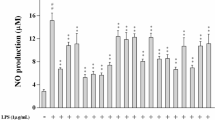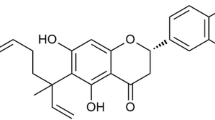Abstract
Diospyros kaki L.f., Ebenaceae, have been used since centuries in traditional medicines in many Asian countries as it contains numerous flavonoids. Out of those plenty flavonoids, quercetin-3-O-β-D-glucopyranosyl-(1 → 6)-β-D-glucopyranoside (1) was found to be one of those active components of the plant. In the present study, we confirmed the non-toxicity behavior of 1 on RAW 264.7 macrophage cells and demonstrated its anti-inflammatory property. Our result indicates that 1 treatment significantly controlled the upregulation of the mitogen-activated protein kinase pathway in a dose-dependent manner in the Escherichia coli produced lipopolysaccharide induced infection background. In addition, its treatment significantly reduced the nitric oxide level, and down-regulated the protein expression of TNF-α, PGE2, IL-1β, IL-6, COX-2, and iNOS in lipopolysaccharide stimulated RAW 264.7 macrophage cells. Taken together, our results suggested that 1 efficiently modulates the MAPK signaling pathway and controlled the inflammatory event. Collectively, the result of the study confirmed the potential of 1 as a potent drug candidate and suggested its usage against the inflammatory diseases.

Graphical Abstract




Similar content being viewed by others
References
Bei W, Zang L, Guo J, Peng W, Xu A, Good DA, Hu Y, Wu W, Hu D, Zhu X, Wei M, Li C (2009) Neuroprotective effects of a standardized flavonoid extract from Diospyros kaki leaves. J Ethnopharmacol 126:134–142
Bredt DS (1999) Endogenous nitric oxide synthesis: biological functions and pathophysiology. Free Radic Res 31:577–596
Cha JY, Jung JY, Jung JY, Lee JR, Cho IJ, Ku SK, Byun SH, Ahn YT, Lee CW, Kim SC, An WG (2013) Inhibitory effects of traditional herbal formula pyungwi-san on inflammatory response in vitro and in vivo. Evid Based Complement Alternat Med. https://doi.org/10.1155/2013/630198
Chang SN, Khan I, Dey DK, Cho KH, Hwang BS, Bae KB, Kang SC, Park JG (2019) Decursinol angelate ameliorates 12-O-tetradecanoyl phorbol-13-acetate (TPA) -induced NF-κB activation on mice ears by inhibiting exaggerated inflammatory cell infiltration, oxidative stress and pro-inflammatory cytokine production. Food Chem Toxicol. https://doi.org/10.1016/j.fct.2019.110699
Cho YH, Kim NH, Khan I, Yu JM, Jung HG, Kim HH, Jang JY, Kim HJ, Kim DI, Kwak JH, Kang SC, An BJ (2016) Anti-inflammatory potential of quercetin-3-O-beta-D-(2″-galloyl)-glucopyranoside and quercetin isolated from Diospyros kaki calyx via suppression of MAP signaling molecules in LPS-induced RAW 264.7 macrophages. J Food Sci 81:C2447–C2456
Dey DK, Khan I, Kang SC (2019a) Anti-bacterial susceptibility profiling of Weissella confusa DD_A7 against the multidrug-resistant ESBL-positive E. coli. Microb Pathog 29:119–130
Dey DK, Koo BG, Sharma C, Kang SC (2019b) Characterization of Weissella confusa DD_A7 isolated from kimchi. LWT 111:663–672
Garcia-Mediavilla V, Crespo I, Collado PS, Esteller A, Sanchez-Campos S, Tunon MJ, Gonzalez-Gallego J (2007) The anti-inflammatory flavones quercetin and kaempferol cause inhibition of inducible nitric oxide synthase, cyclooxygenase-2 and reactive C-protein, and down-regulation of the nuclear factor kappaB pathway in Chang liver cells. Eur J Pharmacol 557:221–229
Imajo M, Tsuchiya Y, Nishida E (2006) Regulatory mechanisms and functions of MAP kinase signaling pathways. IUBMB Life 58:312–317
Jung HG, Kim HH, Paul S, Jang JY, Cho YH, Kim HJ, Yu JM, Lee ES, An BJ, Kang SC, Bang BH (2015) Quercetin-3-O-beta-D-glucopyranosyl-(1➔6)-beta-D-glucopyranoside suppresses melanin synthesis by augmenting p38 MAPK and CREB signaling pathways and subsequent cAMP down-regulation in murine melanoma cells. Saudi J Biol Sci 22:706–713
Jung WK, Lee DY, Park C, Choi YH, Choi I, Park SG, Seo SK, Lee SW, Yea SS, Ahn SC, Lee CM, Park WS, Ko JH, Choi IW (2010) Cilostazol is anti-inflammatory in BV2 microglial cells by inactivating nuclear factor-kappa B and inhibiting mitogen-activated protein kinases. Br J Pharmacol 159:1274–1285
Kim MJ, Park HR, Shin TY, Kim SH (2017) Diospyros kaki calyx inhibits immediate-type hypersensitivity via the reduction of mast cell activation. Pharm Biol 55:1946–1953
Kim SF, Huri DA, Snyder SH (2005) Inducible nitric oxide synthase binds, S-nitrosylates, and activates cyclooxygenase-2. Science 310:1966–1970
Kulinsky VI (2007) Biochemical aspects of inflammation. Biochemistry (Mosc) 72:595–607
Lee CW, Kim SC, Kwak TW, Lee JR, Jo MJ, Ahn YT, Kim JM, An WG (2012) Anti-inflammatory effects of bangpungtongsung-san, a traditional herbal prescription. Evid Based Complement Alternat Med. https://doi.org/10.1155/2012/892943
Liu F, Sun GQ, Gao HY, Li RS, Soromou LW, Chen N, Deng YH, Feng HH (2013) Angelicin regulates LPS-induced inflammation via inhibiting MAPK/NF-kappaB pathways. J Surg Res 185:300–309
Lu J, Wang JS, Kong LY (2011) Anti-inflammatory effects of Huang-Lian-Jie-Du decoction, its two fractions and four typical compounds. J Ethnopharmacol 134:911–918
Nagy G, Clark JM, Buzas EI, Gorman CL, Cope AP (2007) Nitric oxide, chronic inflammation and autoimmunity. Immunol Lett 111:1–5
Olszewska M (2008) Separation of quercetin, sexangularetin, kaempferol and isorhamnetin for simultaneous HPLC determination of flavonoid aglycones in inflorescences, leaves and fruits of three Sorbus species. J Pharm Biomed Anal 48:629–635
Prescott SM, Fitzpatrick FA (2000) Cyclooxygenase-2 and carcinogenesis. Biochim Biophys Acta 1470:M69–M78
Sa YS, Kim SJ, Choi HS (2005) The anticoagulant fraction from the leaves of Diospyros kaki L. has an antithrombotic activity. Arch Pharm Res 28:667–674
Simsek I (2010) TNF inhibitors - new and old agents for rheumatoid arthritis. Bull NYU Hosp Jt Dis 68:204–210
Tennyson AG, Lippard SJ (2011) Generation, translocation, and action of nitric oxide in living systems. Chem Biol 18:1211–1220
Tracey KJ (2002) The inflammatory reflex. Nature 420:853–859
Turner MD, Nedjai B, Hurst T, Pennington DJ (2014) Cytokines and chemokines: at the crossroads of cell signaling and inflammatory disease. Biochim Biophys Acta 1843:2563–2582
Vane JR, Bakhle YS, Botting RM (1998) Cyclooxygenases 1 and 2. Annu Rev Pharmacol Toxicol 38:97–120
Xie C, Xie Z, Xu X, Yang D (2015) Persimmon (Diospyros kaki L.) leaves: a review on traditional uses, phytochemistry and pharmacological properties. J Ethnopharmacol 163:229–240
Yu JH, Jin M, Choi YA, Jeong NH, Park JS, Shin TY, Kim SH (2017) Suppressive effect of an aqueous extract of Diospyros kaki calyx on dust mite extract/2,4-dinitrochlorobenzene-induced atopic dermatitis-like skin lesions. Int J Mol Med 40:505–511
Funding
The study was supported by the Bio-Synergy Research Project (NRF-2017M3A9C4092979), Ministry of Science and ICT. Moreover, the future of the study was planned with the support of the National Research Foundation.
Author information
Authors and Affiliations
Contributions
H-GJ designed the concept of the study. The experiments were done by H-HK, JMY, and HK. H-HK has extracted the compound, JMY has done the cytotoxic assessment and HK has done the molecular study. Y-hC has analyzed the data. The critical evaluation and interpretation of data were done by J-YJ. The article was initially prepared by H-GJ and further drafted by DKD. The article was critically revised by J-YP. Finally, the revised article was approved by SCK and BJA for the submission. All the authors have approved the final revised article for submission.
Corresponding authors
Ethics declarations
Conflict of Interests
All the authors of the manuscript declare that they do not have any conflict of interest neither for financial nor in personal relationships which could influence the work reported in the manuscript.
Ethical Statement
The authors of this paper entitled “The anti-inflammatory and immune-boosting potential of Quercetin-3-O-β-D-glucopyranosyl-(1 → 6)-β-D-glucopyranoside in LPS-stimulated RAW264.7 macrophages” declare that the study has used any animal model system, therefor the study is free out of ethical issues which could influence the work reported in this paper.
Ethical Disclosures
!ᅟ
Protection of Human and Animal Subjects
The authors declare that no experiments were performed on humans or animals for this study. Confidentiality of data. The authors declare that no patient data appear in this article. Right to privacy and informed consent. The authors declare that no patient data appear in this article.
Electronic Supplementary Material
ESM 1
(JPG 697 kb)
Rights and permissions
About this article
Cite this article
Jung, HG., Kim, HH., Dey, D.K. et al. The Anti-inflammatory and Immune-Boosting Potential of Quercetin-3-O-β-D-glucopyranosyl-(1 → 6)-β-D-glucopyranoside in LPS–Stimulated RAW264.7 Macrophages. Rev. Bras. Farmacogn. 30, 233–239 (2020). https://doi.org/10.1007/s43450-020-00027-3
Received:
Accepted:
Published:
Issue Date:
DOI: https://doi.org/10.1007/s43450-020-00027-3




